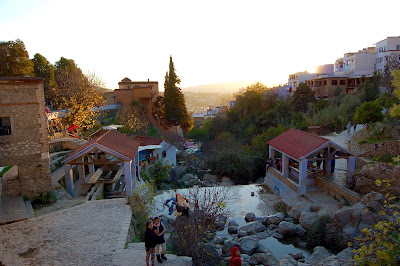A belated blog post this week, as we’ve
just returned from Southern Spain, where we rang in the New Year in Sevilla,
and then celebrated Kate’s birthday in Cordoba, and renewed our visa to boot! 2
ferries, 4 busses, 3 trains, 3 cabs rides and dozens of miles on foot, we’re
back at home, healthy, happy, and ready to dig in here in Tangier for the next
few months. Kate is going to write
about our Spanish travels, so I thought I’d just write a bit about a trip that
we took in December, the week before Mawlid and Christmas.
Chefchaouen is a small village in
the mountains to the southwest of Tangier, about a two-hour drive, or a
three-hour bus ride from the city center. We opted for the bus, which is
remarkably efficient, if a little chaotic at first. Arriving at the main bus
station, you simply seek out someone who is yelling the name of the place that
you want to go. With the accents and overall din, this can be tricky. However,
if you connect with the person, they are generally pretty helpful in getting
you aboard some kind of vehicle headed where you want to go. I’ve ridden the
busses a couple of places in Morocco, and they seem to vary pretty widely in
how modern and comfortable they are. The bus that we took to Chefchaouen was
pretty stifling, and had that tall-ship list going around corners that denoted
that the shocks were on their way out.
 |
| Kate and Cecily on the bus. |
Arriving in Chefchaouen, we made the walk up the hill to our hotel, the Dar Mounir, in the old medina. Passing through the new part of town, the Spanish influence in Chefchaouen was even more pronounced than in Tangier. French was rarely heard, and even Chefchaouen’s name comes from the Spanish word for “The Horns.” The air in Chefchaouen was fresh, and the surrounded hillsides were green and rose steeply from the city walls. The quiet and sense of calm were palpable, especially coming from the manic feel of Tangier.
 |
| The city is beautifully tucked up in a mountain valley, like something from Lord of the Rings. |
Once we crossed into the walled city, though, it becomes clear what draws so many travelers to Chefchaouen: the whole place is blue.
 |
| Looking down on the many alleys of the old city. |
 |
A quick Google Image Search will reveal pictures far beyond my ability to depict the environs, but part of Chefchaouen is a maze of corridors, alleys, and passageways, all a luminous blue. Without sounding too cliché, this is truly a delight for the senses—a feeling akin to being in the deserts of southern Utah. Each turn brings new permutations of the same hue, with varied textures and occasional flashes of color, like prickly pear in the desert.
Beyond the colors (which alone would be enough to warrant a visit), the surrounding mountains, including a mosque which overlooks the valley are wonderful and it made me wish that we had more time to do some hiking in the hills of the Rif. Here is a quick video of the evening call to prayer from the mosque on the hill:
 |
| KEMR and CJJ checking out the view. |
Truly, though, what really made our visit was making a new friend, Mohamed El Mejdki. Mohamed grew up in Chefchaouen, and is currently pursuing a Ph.D in Translation and working with my advisor Khalid, who put us in touch. Mohamed was kind enough to spend a long morning wandering the city with us. Chefchaouen definitely has more of a tourist feel than Tangier, with some more aggressive sales pitches in the medina, and no shortage of characters selling kif, which is grown in the nearby mountains. Spending time with Mohamed really deepened our experience and gave us a locals’ perspective of the place.
 |
| Boys playing soccer. |
On the way home, we took a Grand Taxi instead of the bus, and made it home substantially quicker, even though the taxi stopped on the mountain pass outside of Tangier so that a lady onboard could buy some meat from a butcher shop on the side of the road. In all, an incredibly cultural experience and a stunning place.
 |
| Happy New Year from Kate, Elliot, and Cecily. |
Okay, so we have to go there!
ReplyDeleteIn French 4, the kids researched and presented on the traditions, music and food of Mawlid! Maybe we should Skype with this class so we can talk about it?
ReplyDeleteI enjoy reading your blog!
ReplyDelete